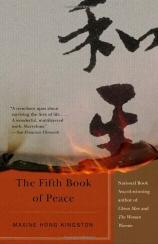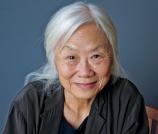Reading Group Guide
Discussion Questions
The Fifth Book of Peace

1. What are the first three Books of Peace, as discussed in the second section of the book "Paper"? How does Kingston's Book of Peace differ from its predecessors, and how are they alike? Who is The Fifth Book of Peace written for? Was Kingston successful in the ambitious goal of writing a Book of Peace? Have your views of war and peace changed after reading Kingston's work?
2. Recalling her workshop with North Vietnamese veterans as her guests, Kingston writes, "I hoped that everyone else realized that we have arrived at peace. We are in peace" [p. 351]. What is this peace, according to Kingston? Kingston writes, "'Vietnam duty provided the most unambiguous source of antiwar sentiment.' War causes peace." [p. 227]. Would Kingston agree or disagree that it is necessary to have war in order to have peace?
3. Kingston writes, "Each one of the veterans has had a moment when life blew apart. If he or she could write the explosion, its every smithereen, and narrate what led to it and came from it, the self and the world would become whole" [p. 336]. How does the process of writing and "talking story" promote peace? Kingston expressly does not want to use the word "healing"–"it implies that something's wrong, that they're unwell, and need fixing" [p. 265]. If healing is not the correct concept, how does writing and retelling help the veterans? What does meditation accomplish that writing and talking do not?
4. What does "sangha"–or community–mean for Kingston? [See p. 364] In the section, "Fire," Kingston writes: "I was proud that no other loss but the community made me cry" [p. 21]. How does one build or rebuild a community? How is this approach to solving problems different from American or Western approaches? What was the nature of the community in "Sanctuary" in Hawai'i in the 1960s [p. 197], and how does it compare to the community that emerges from the veterans' writing workshop in the 1990's?
5. How do the four sections of the book relate to each other? Is this structure effective as a single work? How might the third section, "Water," have had a different impact as a stand-alone work of fiction?
6. In the first section, "Fire," Kingston melds past with present to relate her experience in the Oakland-Berkeley fire of 1991 and to tell the reader about herself and her own life. For example, we learn that she is generally shy [p. 11], and that in her life, she is "not taken care of" but takes "care of everybody else" [p. 29]. What kind of person is Maxine Hong Kingston? What do we learn in this section about her and her life that is essential to understanding her role for the remainder of this book? Does her writing style in this section differ from her style in the other sections and, if so, how?
7. In composing her parting words to her dying father, Kingston contemplates: "We didn't know the Chinese word for 'relax.' Maybe there isn't one. I considered, 'I love you,' but that would be an American sentiment unnatural for me to express, and for him to hear. I should have said: 'Thank you, BaBa, for working hard for us. We love you'" [p. 17]. What other similarities and differences between Chinese and American culture does Kingston identify in the first section? How do these two cultures coexist within Kingston herself? How does this dichotomy between Asian culture and American culture become a subtext for Kingston's work for the Viet Nam war veterans?
8. When Kingston's husband, Earll tells her on the phone, "'I can't believe you tried to get through the fire,'" Kingston's reaction is, "He doesn't know me. We'd been married for twenty-eight years. If I'd asked, or told him to, he would've left the play and come home" [p. 30]. What is the nature of their relationship? How does Kingston's relationship with Earll play a subtle but critical part in all four sections of the book?
9. Observing the burnt remains in the aftermath of the fire, Kingston describes the chimneys as "hundreds of entrances and exits between worlds" [p. 17]. Of the redwoods, she writes that they "drink the fog through hairy bark and evergreen leaves like little hands with many, many fingers. Buddhas have infinite hands, raying everywhere, forever" [pp. 30 --- 31]. As in these passages, how else does Buddhism help inform Kingston's view of the world? At the same time, Kingston's comments seem to indicate her ambivalence about organized religion. Of the war protesters she says, "What was it about religion that got people to remain staunchly peaceful through the long war? . . . But you have to admire the nonreligious individuals. They're able to take a stand without the help of an institution" [p. 131]. And later she comments, "Ideology is what got us into trouble in the first place. Communists have an ideology. Ideology is Marxist, and capitalist. Good for us, I think, we don't have ideology" [p. 330]. What role does religion play in the book?
10. From Wittman's comment about his own marriage: "One reason you espouse yourself to a White person: access to more of the world" [p. 71], to the relations among the "real Hawaiians," the "kachinks," the "katonks," and the "haoles" [p. 78], to the treatment of African Americans as seen in the fate of Clifton and Sheraton [p. 188], matters of race play an important role in the third section, "Water." What role does race play in this section and in the work as a whole? How does Kingston treat race relations in the different parts of the book? Why might Kingston have switched the races of husband and wife from the races of herself and Earll, i.e., it is Wittman, who is Chinese American and Taña, who is White, rather than the other way around. [See pp. 67, 71, and 143]
11. From Wittman's comment about his own marriage: "One reason you espouse yourself to a White person: access to more of the world" [p. 71], to the relations among the "real Hawaiians," the "kachinks," the "katonks," and the "haoles" [p. 78], to the treatment of African Americans as seen in the fate of Clifton and Sheraton [p. 188], matters of race play an important role in the third section, "Water." What role does race play in this section and in the work as a whole? How does Kingston treat race relations in the different parts of the book? Why might Kingston have switched the races of husband and wife from the races of herself and Earll, i.e., it is Wittman, who is Chinese American and Taña, who is White, rather than the other way around. [See pp. 67, 71, and 143]
12. The food Wittman accepts for his family from the Hawaiians on the beach–ironically "wrapped in Saran Wrap (made by Dow Chemical, who makes napalm)" [p. 116]–seems to have an amusing fate as he gives it away piece by piece as the day progresses. [See pp. 125 and 128] Does Kingston use humor in the other sections of the book? Is humor appropriate or effective in advancing the themes of The Fifth Book of Peace?
13. What is the difference in attitude and behavior between the veterans seeking sanctuary in Hawai'i and the two draft dodgers (Sam and Eddie) that Taña and Wittman harbor? [See pp. 228 --- 237]. What might Kingston be trying to illustrate by juxtaposing these two characters with the veterans at the end of the section, "Water"?
14. Kingston writes, "I admit that one motive for starting these workshops is, I want to give my brothers some ways to get over Viet Nam" [p. 292]. Why else does Kingston start the workshops? Is Kingston the right person to bring the veterans together? How is her experience throughout the book both a highly personal journey as well as a very selfless one?
15. Kingston writes, "We blow up the earth, it's natural" [p. 39]. And about Wittman's experiencing the surf in Hawai'i, she writes: "As a conscious being, he had the job of keeping an eye on all this–the kelp, the grasses, the sea grapes. You want to do something about it, find a use for it, fish it, shoot it, eat it, blow it up" [p. 102]. She further observes, "Our human relationship to other creatures: We try to get close to them, and they recede. . . . We have to shoot them to get them to stay still" [p. 151]. Finally, Kingston poses the question, "Why is it that the snow seems at perfection with no prints in it, and still at perfection with the footprints of deer and rabbit? But ruined when a human being walks through it, and marks it with shoe prints?" [p. 288]. In Kingston's view, are human beings at odds with nature or is killing by human beings an inevitable part of nature? Are these two concepts reconcilable?
16. Kingston writes, "Among the letters, one Anonymous Veteran wrote explaining to me why veterans need to report to women. Yes, women are sanctuary; women bring soldiers home" [pp. 248 --- 9]. How does Kingston reconcile this image of women as peaceful sanctuary with the reality of the women veterans? How do the women veterans change the dynamic of the writing workshops? What does the Woman Warrior of Kingston's song represent [pp. 391? --- 92]? Is Kingston's Book of Peace written from a uniquely female perspective? How might a man's Book of Peace be different from Kingston's?
17. The book ends with Kingston asking to stop time–because in time her father died, and soon her mother will die, too [p. 392 --- 93]. What is the relationship between time and peace? What does Kingston teach us about coping with the inevitability of time and with death?
The Fifth Book of Peace
- Publication Date: September 28, 2004
- Paperback: 416 pages
- Publisher: Vintage
- ISBN-10: 0679760636
- ISBN-13: 9780679760634








